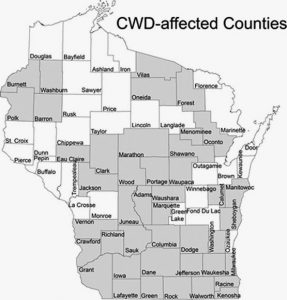Panel to meet two more times
By Greg Seubert

Chronic wasting disease has not shown up in Waupaca County’s white-tailed deer population.
If it does, the county would be added to the list of 18 counties where the disease has been confirmed in wild deer. That list currently consists of Adams, Columbia, Dane, Grant, Green, Iowa, Juneau, Jefferson, Kenosha, Lafayette, Portage, Racine, Richland, Rock, Sauk, Walworth, Washburn and Waukesha counties.
Wisconsin’s County Deer Advisory Councils are meeting this month to review the state’s CWD Response Plan. The state Department of Natural Resources uses the plan, which covers 2010-25, as a guide to address CWD, a contagious neurological disease affecting deer, elk, moose and reindeer, in Wisconsin.
Waupaca County’s council met for two hours Jan. 11 in Manawa. About 15 people attended the meeting at Little Wolf High School.
Councils in each of Wisconsin’s 72 counties meet annually to review deer herd information and develop preliminary recommendations regarding antlerless harvest quotas, antlerless permit levels and other season options for 2016.
The Waupaca County council made headlines in March after recommending antlerless-only gun and bow hunts for the county in 2016 as a way to control the local deer herd population. The council later voted against the antlerless-only seasons in April.
Five of the six voting members on last year’s council are still on the panel: Brian Haase, Ben Knaack, Doug Korth, David Lindenstruth and Lance Penney. Bill Krostue replaced John Hedtke, who stepped down. The council also includes five nonvoting members, Wisconsin Conservation Congress delegates Arlyn Splitt and Bob Knorr; and state Department of Natural Resources employees Jake Fries (wildlife biologist), Mark Schraufnagel (conservation warden) and Mike Schuessler (forester).
The Jan. 11 meeting’s agenda focused on the CWD Response Plan, but the council will eventually make recommendations for Waupaca County’s 2017 hunting seasons at upcoming meetings in March and April, Splitt said.
“This meeting will focus specifically on CWD and the response plan,” Splitt said. “Other items will be discussed at upcoming meetings in March and April.”
A date for the March meeting has yet to be set, although Splitt said it will be held March 13-16 or March 20-23. The April meeting is scheduled for Monday, April 17. Times and locations for the two meetings will be announced later.
Fries updated the council on the DNR’s CWD monitoring plan.
“It’s always fatal,” he said. “Symptoms are not always visible in deer when they’re infected. It’s not always readily apparent. It’s a contagious disease spread from deer to deer. It can also be spread through a contaminated environment.”
Advanced symptoms included emaciation, no fear of humans and drooling, he said.
“Adult bucks are more likely to have the disease than adult does and older deer are more likely to have the disease than younger deer,” Fries said.
Wisconsin’s first positive CWD cases were found in 2002 in through testing of hunter-harvested deer near Mount Horeb in November 2001.
The disease later turned up in several deer at a former game farm near Almond in southern Portage County. The state purchased the 80-acre site in 2011 for $465,000 after it had been vacant for several years and DNR officials said the property will be used for research.
